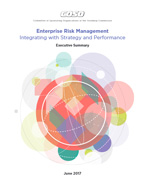 Committee of Sponsoring Organizations of the Treadway Commission
Committee of Sponsoring Organizations of the Treadway Commission
Sinopse: In keeping with its overall mission, the COSO Board commissioned and published in 2004 Enterprise Risk Management—Integrated Framework. Over the past decade, that publication has gained broad acceptance by organizations in their efforts to manage risk. However, also through that period, the complexity of risk has changed, new risks have emerged, and both boards and executives have enhanced their awareness and oversight of enterprise risk management while asking for improved risk reporting. This update to the 2004 publication addresses the evolution of enterprise risk management and the need for organizations to improve their approach to managing risk to meet the demands of an evolving business environment. The updated document, now titled Enterprise Risk Management—Integrating with Strategy and Performance, highlights the importance of considering risk in both the strategy-setting process and in driving performance. The first part of the updated publication offers a perspective on current and evolving concepts and applications of enterprise risk management. The second part, the Framework, is organized into five easy-to-understand components that accommodate different viewpoints and operating structures, and enhance strategies and decision-making. In short, this update:
- Provides greater insight into the value of enterprise risk management when setting and carrying out strategy.
- Enhances alignment between performance and enterprise risk management to improve the setting of performance targets and understanding the impact of risk on performance.
- Accommodates expectations for governance and oversight.
- Recognizes the globalization of markets and operations and the need to apply a common, albeit tailored, approach across geographies.
- Presents new ways to view risk to setting and achieving objectives in the context of greater business complexity.
- Expands reporting to address expectations for greater stakeholder transparency.
- Accommodates evolving technologies and the proliferation of data and analytics in sup-porting decision-making.
- Sets out core definitions, components, and principles for all levels of management involved in designing, implementing, and conducting enterprise risk management practices.
